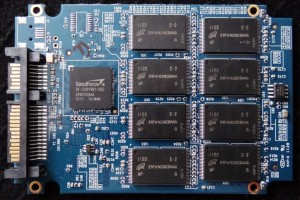TERADRIVE CT3 COMPONENTS
For the readers benefit, we removed the four screws, scraped off the security sticker and removed the rear plate in order to provide a first glimpse of the PCB which is secured to the housing by four screws. Removal of the four interior screws allowed us to separate the PCB from the housing in order to take these shots:

 The three main components of the PCB are the SATA 3 interface which plugs into your computer, the SandForce SF-2281 processor and 16 pieces of Micron 25nm asynchronous NAND flash memory (29F64G08CBAAA), each of which is 8GB in capacity for a total of 128GB total RAW capacity. If the last three letters on this NAND were ‘AAB’, it would be Microns premium synchronous memory in use.
The three main components of the PCB are the SATA 3 interface which plugs into your computer, the SandForce SF-2281 processor and 16 pieces of Micron 25nm asynchronous NAND flash memory (29F64G08CBAAA), each of which is 8GB in capacity for a total of 128GB total RAW capacity. If the last three letters on this NAND were ‘AAB’, it would be Microns premium synchronous memory in use.
 SandForce requires one 8GB memory module for necessary firmware and over provisioning needs which brings us to the advertised capacity of 120GB. Things don’t stop there though as formatting then reduces the final available user capacity to 112GB.
SandForce requires one 8GB memory module for necessary firmware and over provisioning needs which brings us to the advertised capacity of 120GB. Things don’t stop there though as formatting then reduces the final available user capacity to 112GB.
BENCHMARK PROTOCOL AND THE TEST BENCH
 This is The SSD Review Test Bench Number One. A quick click on the photo will give you a better look.
This is The SSD Review Test Bench Number One. A quick click on the photo will give you a better look.
In testing, our main objective is to obtain results as pure and as accurate as possible and we want to ensure that no anomalies slip through. Simply put, we want to provide you with the absolute best results the tested hardware can provide. Repetition in testing is standard and, if necessary, we may conduct specific tests in Windows 7 safe mode to ensure the OS has little to no influence on the end result.
In order to validate and confirm our findings, testing is supported by industry accepted benchmark programs. All results are displayed through capture of the actual benchmark for better understanding of the testing process by the reader.
 We would like to thank Gigabyte, Corsair, MSI, OCZ, Fractal-Design, and Icy Dock for sponsoring components of our Test Bench.
We would like to thank Gigabyte, Corsair, MSI, OCZ, Fractal-Design, and Icy Dock for sponsoring components of our Test Bench.
SSD COMPRESSION AND TESTING FLUCTUATIONS
All SSDs are not created equal and many new SSD enthusiasts realize that when they test their new drive to confirm specifications and ensure all is in order. SandForce controlled SSDs use compression techniques in storage whereas many others do not. This creates a bit of confusion when enthusiasts test the drive with random data through benchmarking programs such as AS SSD and Crystal Diskmark (random data sample). The results seem to be lower than the listed specifications.
The results actually present a false portrayal of the drives ability when compared to other drives such as the Samsung 470 Series and Crucial M4 SSDs that we have reviewed previously. It is for this reason that all of our comparison testing is done through PCMark Vantage. PCMark Vantage HDD Suite simply provides evaluation results based on transfer speeds reached through typical user patterns. Vantage provides a better testing medium, in that, it sees through the typical synthetic benchmarks and provides us with true to life results of the drive.
BENCHMARK SOFTWARE
Software used for testing by The SSD Review consists of ATTO Disk Benchmark, Crystal DiskMark, Anvil Storage Utilities, HDTune Pro along with FutureMark PCMark Vantage.
All do a great job of showing us the numbers that we want to see, or dont want to see in some cases, while PCMark Vantage x64 is an excellent program which recreates tests that mimic the average users activity, all the while providing a medium to measure each.
 The SSD Review The Worlds Dedicated SSD Education and Review Resource |
The SSD Review The Worlds Dedicated SSD Education and Review Resource | 
Great review. I got to get me one of these.